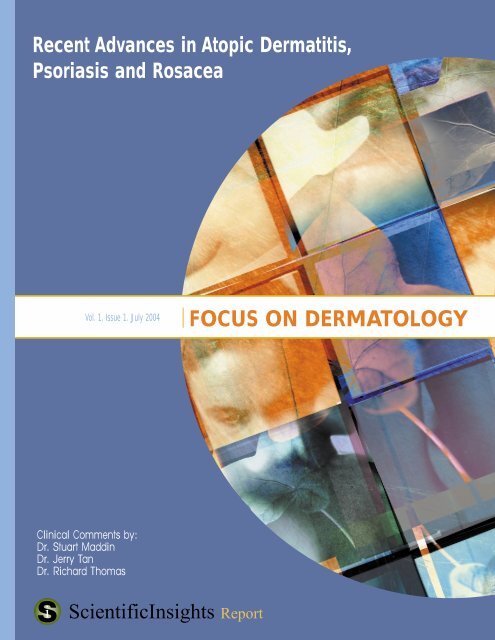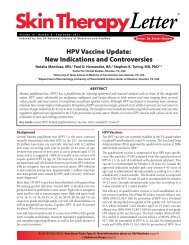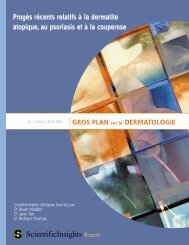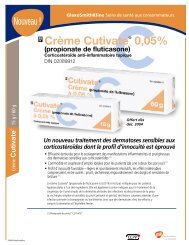focus on dermatology - Skin Therapy Letter
focus on dermatology - Skin Therapy Letter
focus on dermatology - Skin Therapy Letter
Create successful ePaper yourself
Turn your PDF publications into a flip-book with our unique Google optimized e-Paper software.
Recent Advances in Atopic Dermatitis,<br />
Psoriasis and Rosacea<br />
Vol. 1. Issue 1. July 2004<br />
Clinical Comments by:<br />
Dr. Stuart Maddin<br />
Dr. Jerry Tan<br />
Dr. Richard Thomas<br />
ScientificInsights Report<br />
FOCUS ON DERMATOLOGY
Focus <strong>on</strong> Dermatology Vol. 1. Issue 1. July 2004<br />
Introductory Comment from<br />
Dr. Charles Lynde - Past President CDA<br />
It is difficult for physicians today to stay current with regard to recent publicati<strong>on</strong>s.<br />
Focus <strong>on</strong> Dermatology brings to us a c<strong>on</strong>cise overview of recent clinical research<br />
combined with valuable clinical commentaries provided by our peers. This newsletter<br />
gives Canadian physicians a forum to share their experiences and to increase our<br />
collective understanding of new therapeutic opti<strong>on</strong>s for treating our patients. The<br />
c<strong>on</strong>tent included in the report will be chosen by an Editorial Advisory Board composed<br />
of dermatologists. Their goal is to provide a publicati<strong>on</strong> that will offer new and<br />
different therapeutic opti<strong>on</strong>s for managing your patient’s c<strong>on</strong>diti<strong>on</strong>s. I welcome this<br />
educati<strong>on</strong>al and informative report and look forward to the upcoming issues.<br />
I would like to thank GlaxoSmithKline C<strong>on</strong>sumer Healthcare for sp<strong>on</strong>soring this<br />
newsletter. GSK C<strong>on</strong>sumer Healthcare has chosen to sp<strong>on</strong>sor this Scientific Insights<br />
Report to help physicians keep current and understand the outcomes of some recent<br />
clinical trials in the <strong>dermatology</strong> field.<br />
Editorial Board<br />
Dr. Gord<strong>on</strong> Searles<br />
Dermatologist, Edm<strong>on</strong>t<strong>on</strong>, Alberta<br />
Clinical Associate Professor,<br />
University of Alberta<br />
Editor<br />
B<strong>on</strong>nie Kuehl, PhD<br />
Scientific Insights<br />
C<strong>on</strong>sulting Group<br />
www.sicg.ca<br />
Dr. Jerry Tan<br />
Dermatologist, Windsor, Ontario<br />
Adjunct Professor,<br />
University of Western Ontario<br />
Dr. Marni Wiseman<br />
Dermatologist, Winnipeg, Manitoba<br />
Assistant Professor,<br />
University of Manitoba<br />
Comments and feedback can be directed to the following:<br />
Scientific Insights C<strong>on</strong>sulting Group,<br />
Mississauga, Ontario<br />
Fax: 905-823-3930<br />
Email:editor@sicg.ca
Introductory Comment from<br />
the Editor B<strong>on</strong>nie Kuehl PhD<br />
W elcome<br />
to the inaugural issue of Focus <strong>on</strong> Dermatology. This newsletter will provide you with an <strong>on</strong>going review of the<br />
literature, reporting recent dermatological clinicals from around the world. The c<strong>on</strong>tent will come from peer reviewed<br />
journals as well as presentati<strong>on</strong>s from c<strong>on</strong>ferences and meetings. A clinical comment from our Editorial Board or <strong>on</strong>e of<br />
your peers will appear with each abstract to help you understand the applicati<strong>on</strong> of the informati<strong>on</strong> to your clinical practice.<br />
Each issue will <str<strong>on</strong>g>focus</str<strong>on</strong>g> <strong>on</strong> a specific aspect of <strong>dermatology</strong> with an emphasis <strong>on</strong> therapeutic opti<strong>on</strong>s to manage the c<strong>on</strong>diti<strong>on</strong>. The<br />
therapeutic opti<strong>on</strong>s discussed will include emerging and traditi<strong>on</strong>al treatments (topical corticosteroids, immunomodulators,<br />
coal tar) and n<strong>on</strong>-traditi<strong>on</strong>al treatments (emollient therapy, herbal remedies).<br />
I am pleased to introduce you to the Editorial Board: Dr. Jerry Tan; Dr. Marni Wiseman; and Dr. Gord<strong>on</strong> Searles. Dr. Tan is an<br />
Adjunct Professor at the University of Western Ontario. Dr. Tan’s interests include epidemiological and clinical research in acne<br />
and rosacea. Dr. Marni Wiseman is the Director of Cutaneous Oncology at Cancer Care Manitoba. Dr. Wiseman’s interests include<br />
skin cancer, vulvar disease and hair disorders. Dr. Gord<strong>on</strong> Searles has an academic positi<strong>on</strong> at the University of Alberta. Dr. Searles’<br />
interests include wound care and dermatologic manifestati<strong>on</strong>s of internal disease. I am also looking forward to working with<br />
this group and to asking dermatologists/physicians from across the country for their clinical comments <strong>on</strong> a variety of subjects. A<br />
very special thank you to Dr. Stuart Maddin for his assistance in getting this publicati<strong>on</strong> launched. Dr. Maddin is very excited<br />
about this new publicati<strong>on</strong> which will update Canadian physicians <strong>on</strong> recent clinicals and dermatological reports from around the<br />
world. He has agreed to provide <strong>on</strong>-going assistance to this new publicati<strong>on</strong> in order to make it easier for dermatologists to be<br />
more aware of new therapies for their patients.<br />
This first issue will address recent advances in therapeutic opti<strong>on</strong>s for a variety of skin diseases including atopic dermatitis,<br />
psoriasis, and rosacea. Clinical commentaries for this first issue have been supplied by Dr. Stuart Maddin, Dr. Jerry Tan, and Dr.<br />
Richard Thomas (Clinical Assistant Professor, University of British Columbia). I extend a special thanks to each of them for their<br />
valuable comments.<br />
T he<br />
Vol. 1. Issue 1. July 2004<br />
Focus <strong>on</strong> Dermatology<br />
study by Allen and colleagues (2003), dem<strong>on</strong>strates that pimecrolimus cream is effective and well tolerated when<br />
treating atopic dermatitis in children and infants. While the study, by Thiboutot and colleagues (2003), reports<br />
<strong>on</strong> two robust clinicals that clearly dem<strong>on</strong>strate the efficacy of azelaic acid gel as an effective treatment for<br />
moderate, papulopustular rosacea.<br />
Other abstracts offer new opti<strong>on</strong>s for the treatment of several skin c<strong>on</strong>diti<strong>on</strong>s. Kang et al. (2003) found that there were<br />
significant improvements in both atopic dermatitis of the head/neck and n<strong>on</strong>-head/neck treated areas following 12-weeks of<br />
treatment with 0.1% and 0.03% tacrolimus. Mark and colleagues (2003) found that intense pulse light treatment was effective<br />
in reducing rosacea associated blood flow, telangiectasia and erythema. This study was performed <strong>on</strong> a small number of patients<br />
but does offer an objective and quantitative measure of improvement of the patient’s rosacea and suggests why light therapy can be<br />
effective. Carb<strong>on</strong>i et al. (2004) reported <strong>on</strong> the treatment of psoriasis with fumaric acid esters. This treatment was found to be safe,<br />
effective and well tolerated with over 82% of patients achieving remissi<strong>on</strong>.<br />
All too often, clinicians struggle with choosing between drugs for the treatment of specific dermatoses. Such c<strong>on</strong>cerns are<br />
addressed in the studies comparing methotrexate with cyclosporine therapy for the treatment of moderate-to-severe psoriasis<br />
(Heydendael et al. (2003)) and comparing 15% azelaic acid with 0.75% metr<strong>on</strong>idazole gel in the treatment of rosacea<br />
(Elewski et al. (2003)).<br />
Another c<strong>on</strong>cern is whether combined therapy offers your patients any advantages over m<strong>on</strong>otherapy in the treatment of<br />
psoriasis. Grundmann and colleagues (2004) found that combining UVB with PUVA had a higher efficacy than either m<strong>on</strong>otherapy<br />
al<strong>on</strong>e.<br />
Finally, there are a few publicati<strong>on</strong>s that discuss the importance of topical emollients, as a moisturizer or as the base for a<br />
pharmacological preparati<strong>on</strong>, in repairing and restoring moisture skin barrier functi<strong>on</strong>. Goustas (2003) and Zhai and<br />
colleagues (2003) in their studies measured TEWL and found that the vehicle/base of a topical corticosteroid can have a<br />
significant effect <strong>on</strong> restoring skin hydrati<strong>on</strong>. Goustas, in his study <strong>on</strong> Eumovate, suggests that the cream base or vehicle can<br />
offer moisturizing potential that is complementary to the anti-inflammatory acti<strong>on</strong> provided by the topical corticosteroid.<br />
This first issue of Focus <strong>on</strong> Dermatology brings an interesting mix of treatment opti<strong>on</strong>s including combined therapies of new or<br />
existing drugs. This newsletter is a vehicle for sharing clinical informati<strong>on</strong> and experience. If you have any comments or thoughts<br />
<strong>on</strong> the c<strong>on</strong>tent of the newsletter or input for future issues please send them to me at editor@sicg.ca.<br />
1
2<br />
Focus <strong>on</strong> Dermatology Vol. 1. Issue 1. July 2004<br />
Atopic Dermatitis<br />
1. Systemic exposure, tolerability, and efficacy of pimecrolimus cream 1% in atopic<br />
dermatitis patients.<br />
Allen, B. R., Lakhanpaul, M., Morris, A., Lateo, S., Davies, T., Scott, G., Cardno, M., Ebelin, M. E.,<br />
Burtin, P., and Stephens<strong>on</strong>, T. J. Arch Dis. Child. 88:969-973; (2003)<br />
Abstract: AIMS: To measure pimecrolimus blood c<strong>on</strong>centrati<strong>on</strong>s and to evaluate<br />
tolerability and efficacy in children and infants treated topically for atopic dermatitis<br />
with pimecrolimus cream 1% for three weeks. METHODS: Three open label,<br />
n<strong>on</strong>-c<strong>on</strong>trolled, multiple topical dose studies were c<strong>on</strong>ducted in children aged 8-14<br />
years (study A, ten patients), and in infants aged 8-30 m<strong>on</strong>ths (study B, eight patients)<br />
and 4-11 m<strong>on</strong>ths (study C, eight patients). Pimecrolimus blood c<strong>on</strong>centrati<strong>on</strong>s were<br />
determined <strong>on</strong> days 4 and 22 of treatment, and at end of study. Efficacy was assessed<br />
using the Eczema Area and Severity Index (EASI). RESULTS: Pimecrolimus blood<br />
c<strong>on</strong>centrati<strong>on</strong>s were c<strong>on</strong>sistently low, typically (81%) below 1 ng/ml, with more than<br />
half of the measurements below the assay limit of quantitati<strong>on</strong> (0.5 ng/ml) in<br />
studies A and B. The highest blood c<strong>on</strong>centrati<strong>on</strong> measured throughout the three<br />
studies was 2.6 ng/ml. The cream was well tolerated, locally and systemically. The most<br />
comm<strong>on</strong> adverse event suspected to be related to study medicati<strong>on</strong> was a transient<br />
mild to moderate stinging sensati<strong>on</strong> at the applicati<strong>on</strong> site in 5/26 patients. There was<br />
no indicati<strong>on</strong> of any systemic adverse effect. The patients resp<strong>on</strong>ded well to<br />
therapy with a rapid <strong>on</strong>set of acti<strong>on</strong>, usually within four days. Median reducti<strong>on</strong>s of<br />
EASI from baseline at day 22 were 55% (study A), 63% (study B), and 83% (study C).<br />
2. Safe treatment of head/neck AD with tacrolimus ointment.<br />
Kang, S., Paller, A., Soter, N., Satoi, Y., Rico, M. J., and Hanifin, J. M. J Dermatolog. Treat.<br />
14:86-94; (2003)<br />
Abstract: BACKGROUND: Atopic dermatitis(AD) with head and neck involvement is<br />
comm<strong>on</strong> and therapeutically challenging. METHODS: Efficacy and safety data specific<br />
to treatment of head/neck regi<strong>on</strong>s with tacrolimus ointment (Protopic) from three<br />
double-blind, randomized, vehicle-c<strong>on</strong>trolled studies are reported. A total of 631<br />
adult and 352 pediatric patients with moderate to severe atopic dermatitis applied<br />
the vehicle, 0.03% or 0.1% tacrolimus ointment twice daily to affected areas for up<br />
to 12 weeks. RESULTS: Significant improvements from baseline to end of treatment<br />
for signs of atopic dermatitis (erythema, edema, excoriati<strong>on</strong>, oozing, scaling, and<br />
lichenificati<strong>on</strong>) were noted for head/neck and n<strong>on</strong>-head/neck areas treated with<br />
either 0.03% or 0.1% tacrolimus ointment (p
3. One-year follow up of children treated with Chinese medicinal herbs for<br />
atopic eczema.<br />
Sheehan, M. P. and Athert<strong>on</strong>, D. J. Br. J Dermatol. 130:488-493; (1994)<br />
VIEW THE ABSTRACT ONLINE:<br />
http://www.ncbi.nlm.nih.gov//entrez/query.fcgi?cmd=Retrieve&db=PubMed&dopt=<br />
Citati<strong>on</strong>&list_uids=8186115<br />
4. The moisturisati<strong>on</strong> potential of the emollient base of clobetas<strong>on</strong>e butyrate<br />
cream and clobetas<strong>on</strong>e butyrate 0.05% cream: results from two comparative studies.<br />
Goustas, P. J. Clin. Res. 6:1-12; (2003)<br />
Two small, laboratory-based, single-blind, and intra-individual studies involving<br />
volunteers with dry/normal skin were performed to evaluate the moisturisati<strong>on</strong><br />
potential of the emollient base of clobetas<strong>on</strong>e butyrate (CB) cream (Eumo base) and<br />
Eumovate (CB 0.05%) cream. In Study A (n=20), when compared with untreated sites,<br />
2 cm 2 sites <strong>on</strong> lower legs treated with Eumobase 10uL/cm 2 had statistically significant<br />
greater skin capacitance (i.e. hydrati<strong>on</strong>) over 6 h than sites treated with other<br />
emollient creams (E45, Unguentum M and Diprobase). In Study B (n=13), when<br />
compared with untreated c<strong>on</strong>trols, 5cm 2 sites <strong>on</strong> volar forearms treated with CB<br />
0.05% 10uL/cm 2 cream had statistically significant greater skin capacitance over 24h<br />
than four hydrocortis<strong>on</strong>e-based creams (Eurax HC, Efcortelan 0.5%, Efcortelan 1.0%<br />
and Hc45). With their high c<strong>on</strong>centrati<strong>on</strong> of glycerol (25% w/w), Eumo Base and CB<br />
0.05% cream have better moisturising potential than the three other<br />
emollient- and four hydrocortis<strong>on</strong>e-based creams, and the emollient base cream is<br />
cosmetically acceptable (as assessed by patient questi<strong>on</strong>naire in Study A (n=60)). The<br />
moisturising potential is complementary to the antiinflammatory acti<strong>on</strong> of CB 0.05%<br />
and may promote faster healing of skin flare-ups.<br />
Vol. 1. Issue 1. July 2004<br />
Focus <strong>on</strong> Dermatology<br />
The loss of barrier functi<strong>on</strong> is important in<br />
many of the c<strong>on</strong>diti<strong>on</strong>s that we treat especially<br />
atopic dermatitis. If we can assume that the<br />
increased hydrati<strong>on</strong> achieved by the clobetas<strong>on</strong>e<br />
butyrate cream base (Eumo ® base) <strong>on</strong> normal skin<br />
also carries <strong>on</strong> to atopic skin it would be a very<br />
attractive product compared with the other<br />
bases. Cosmetic acceptability and therefore better<br />
compliance is very welcomed by many of my<br />
patients. (commentary Dr. Thomas)<br />
3
4<br />
Focus <strong>on</strong> Dermatology Vol. 1. Issue 1. July 2004<br />
Psoriasis<br />
5. Fumaric acid esters in the treatment of psoriasis: an Italian experience.<br />
Carb<strong>on</strong>i, I., De Felice, C., De, Sim<strong>on</strong>i, I, Soda, R., and Chimenti, S. J Dermatolog. Treat.<br />
15:23-26; (2004)<br />
BACKGROUND: Psoriasis is a comm<strong>on</strong>, chr<strong>on</strong>ic, cell-mediated, inflammatory<br />
skin disease. Treatment limitati<strong>on</strong>s and a developing understanding of its<br />
pathogenesis <strong>on</strong>a molecular level have encouraged much interest in the field of<br />
immunomodulatorytherapy. OBJECTIVE: To evaluate the efficacy and safety of<br />
fumaric acid esters, in particular dimethylfumarate (DMF), in the treatment of<br />
moderate to severe plaquepsoriasis intolerant and/or resistant to other<br />
c<strong>on</strong>venti<strong>on</strong>al systemic therapies. METHODS: A total of 40 patients were<br />
enrolled in this study. DMF was orally administered at the daily dose of 30 mg<br />
up to 360 mg for a minimum of 6 m<strong>on</strong>thstreatment. Patients were followed-up<br />
with psoriasis area and severity index (PASI)score assessment, and clinical<br />
and photographic documentati<strong>on</strong>. RESULTS: A total of33 (82.5%) patients<br />
achieved complete clinical remissi<strong>on</strong> with DMF treatment: eightafter 3 m<strong>on</strong>ths<br />
and 25 after 6 m<strong>on</strong>ths. Adverse events, such as intolerable abdominalcramps<br />
and incoercible diarrhoea, occurred in four patients who, for this<br />
reas<strong>on</strong>,interrupted therapy.<br />
6. Narrowband UVB and cream psoralen-UVA combinati<strong>on</strong> therapy for<br />
plaque-type psoriasis.<br />
Grundmann-Kollmann, M., Ludwig, R., Zollner, T. M., Ochsendorf, F., Thaci, D., Boehncke, W. H.,<br />
Krutmann, J., Kaufmann, R., and Podda, M. J Am. Acad. Dermatol. 50:734-739; (2004)<br />
VIEW THE ABSTRACT ONLINE:<br />
http://www2.us.elsevierhealth.com/scripts/om.dll/serve?retrieve=/pii/S0190962203007928&<br />
CONCLUSION: The findings suggest<br />
that DMF is a safe, effective and<br />
well-tolerated l<strong>on</strong>g-term oral treatment<br />
worthy of c<strong>on</strong>siderati<strong>on</strong> for selective<br />
patients.<br />
PM:14754645 Used with permissi<strong>on</strong> of the Taylor &<br />
Francis Group.<br />
Combinati<strong>on</strong> therapy involving the use of<br />
narrowband UVB and specifically formulated<br />
psoralen cream (0.001% 8-MOP in Dorithin<br />
cream) provides greater efficacy compared with<br />
either agent as m<strong>on</strong>otherapy. As well, the<br />
cumulative UV doses are lower and anatomic<br />
sites which are resistant, such as the palms, etc.<br />
resp<strong>on</strong>d more quickly with combinati<strong>on</strong> therapy.<br />
(commentary Dr. Maddin)
7. Methotrexate versus cyclosporine in moderate-to-severe chr<strong>on</strong>ic plaque<br />
psoriasis. Heydendael, V. M., Spuls, P. I., Opmeer, B. C., de Borgie, C. A., Reitsma, J. B.,<br />
Goldschmidt, W. F., Bossuyt, P. M., Bos, J. D., and de Rie, M. A. N. Engl. J Med.<br />
349:658-665; (14-8-2003)<br />
VIEW THE ABSTRACT ONLINE:<br />
http://c<strong>on</strong>tent.nejm.org/cgi/c<strong>on</strong>tent/abstract/349/7/658?view=abstractpmid=12917302<br />
Vol. 1. Issue 1. July 2004<br />
Focus <strong>on</strong> Dermatology<br />
5
6<br />
Focus <strong>on</strong> Dermatology Vol. 1. Issue 1. July 2004<br />
Rosacea<br />
9. A comparis<strong>on</strong> of 15% azelaic acid gel and 0.75% metr<strong>on</strong>idazole gel in the topical<br />
treatment of papulopustular rosacea: results of a randomized trial.<br />
Elewski, B. E., Fleischer, A. B., Jr., and Pariser, D. M. Arch Dermatol. 139:1444-1450; (2003)<br />
VIEW THE ABSTRACT ONLINE:<br />
http://archderm.ama-assn.org/cgi/c<strong>on</strong>tent/abstract/139/11/1444<br />
10. Objective and quantitative improvement of rosacea-associated erythema after<br />
intense pulsed light treatment. Mark, K. A., Sparacio, R. M., Voigt, A., Marenus, K., and<br />
Sarnoff, D. S. Dermatol Surg. 29:600-604; (2003)<br />
VIEW THE ABSTRACT ONLINE:<br />
http://www.blackwell-synergy.com/openurl?genre=article&sid=nlm:pubmed&issn=1076-<br />
0512&date=2003&volume=29&issue=6&spage=600<br />
Metr<strong>on</strong>idazole has previously been c<strong>on</strong>sidered to<br />
be the gold standard of topical rosacea therapy.<br />
This active comparator RCT dem<strong>on</strong>strated that<br />
15% azelaic acid gel is statistically superior to<br />
0.75% metr<strong>on</strong>idazole gel twice daily over 15 wks<br />
in moderate, papulopustular facial rosacea. The<br />
magnititude of difference, however, may be of<br />
marginal clinical relevance. Of particular clinical<br />
interest to practiti<strong>on</strong>ers is the potential for<br />
enhanced clinical efficacy by combining the use<br />
of these agents. (commentary Dr. Tan)<br />
This is <strong>on</strong>e of few studies in rosacea using objective<br />
quantifiable evaluati<strong>on</strong>s of rosacea-associated<br />
erythema. Intense pulsed light treatment resulted<br />
in improvement in the three outcome parameters:<br />
blood flow, erythema intensity and area of<br />
telangiectasiae. However, this study was small, and<br />
was not c<strong>on</strong>trolled – thus c<strong>on</strong>founding factors<br />
cannot be excluded. A 1/2 face trial design may<br />
have provided greater validati<strong>on</strong> in this small study.<br />
The durati<strong>on</strong> of improvement and extent of patient<br />
satisfacti<strong>on</strong> would also be of clinical interest. This<br />
small study should provide the impetus for<br />
pursuing a larger c<strong>on</strong>trolled clinical trial with<br />
relevant clinical endpoints. (commentary Dr. Tan)
11. Efficacy and safety of azelaic acid (15%) gel as a new treatment for<br />
papulopustular rosacea: results from two vehicle-c<strong>on</strong>trolled, randomized<br />
phase III studies. Thiboutot, D., Thieroff-Ekerdt, R., and Graupe, K. J Am. Acad. Dermatol.<br />
48:836-845; (2003)<br />
VIEW THE ABSTRACT ONLINE:<br />
http://www2.us.elsevierhealth.com/scripts/om.dll/serve?retrieve=/pii/S0190962203004055&<br />
Emollients<br />
12.Hydrating effects of a corticoid oil formulati<strong>on</strong> and its vehicle <strong>on</strong> human skin.<br />
Zhai, H., Ramirez, R. G., and Maibach, H. I. <strong>Skin</strong> Pharmacol. Appl. <strong>Skin</strong> Physiol.<br />
16:367-371; (2003)<br />
Factors in the treatment of atopic dermatitis include restoring skin moisture and<br />
reducing inflammati<strong>on</strong>. This study evaluated a corticoid oil formulati<strong>on</strong> and its<br />
comp<strong>on</strong>ents with respect to their skin hydrati<strong>on</strong> potential. Ten healthy Caucasians<br />
were enrolled. Five test sites <strong>on</strong> the left and right forearm of each subject were<br />
tested: <strong>on</strong>e site served as a normal skin c<strong>on</strong>trol (without treatment), whereas four<br />
were wetted by spraying distilled water (approximately 0.1 ml) over a 3 cm2 skin<br />
surface area, and spraying was repeated every 5 min for a total of three applicati<strong>on</strong>s.<br />
Five minutes after the final applicati<strong>on</strong>, 0.2 ml of the corticoid oil formulati<strong>on</strong>,<br />
moisturizing vehicle, and plain peanut oil were applied to each pre-designated site<br />
(3 cm2); <strong>on</strong>e site was kept as a blank c<strong>on</strong>trol (water saturati<strong>on</strong> <strong>on</strong>ly). Thirty minutes<br />
later, test sites were gently wiped with paper tissues, and visual scoring,<br />
transepidermal water loss (TEWL), and capacitance were recorded and repeated at 2<br />
and 3 h. The corticoid oil formulati<strong>on</strong>, plain peanut oil, and moisturizing vehicle<br />
significantly increased skin hydrati<strong>on</strong> 30 min after each single applicati<strong>on</strong>, with no<br />
statistically significant difference am<strong>on</strong>g the treatments at any point. The corticoid oil<br />
formulati<strong>on</strong> and plain peanut oil slightly but not significantly elevated TEWL 30 min<br />
after applicati<strong>on</strong>. The results support intuitive dermatologic judgment of advising<br />
patients to apply moisturizing medicaments after bathing.<br />
Vol. 1. Issue 1. July 2004<br />
Focus <strong>on</strong> Dermatology<br />
These 2 large vehicle-c<strong>on</strong>trolled RCTs with a total<br />
of 664 patients dem<strong>on</strong>strated the efficacy of<br />
15% azelaic acid (15%) gel in treatment of<br />
moderate inflammatory rosacea in reducing<br />
inflammatory lesi<strong>on</strong>s and erythema and in<br />
improving global rosacea assessments. Although<br />
typically mild and transient, 38% of subjects<br />
reported burning or stinging with active treatment.<br />
(commentary Dr. Tan)<br />
PM:14528060 Used with permissi<strong>on</strong> of S. Karger<br />
AG, Basel.<br />
7
8<br />
Focus <strong>on</strong> Dermatology Vol. 1. Issue 1. July 2004<br />
13.Role of topical emollients and moisturizers in the treatment of dry skin<br />
barrier disorders.<br />
Loden, M. Am. J Clin. Dermatol. 4:771-788; (2003)<br />
Emollients and moisturizing creams are used to break the dry skin cycle and to<br />
maintain the smoothness of the skin. The term 'moisturizer' is often used<br />
syn<strong>on</strong>ymously with emollient, but moisturizers often c<strong>on</strong>tain humectants in order to<br />
hydrate the stratum corneum. Dryness is frequently linked to an impaired barrier<br />
functi<strong>on</strong> observed, for example, in atopic skin, psoriasis, ichthyosis, and c<strong>on</strong>tact<br />
dermatitis. Dryness and skin barrier disorders are not a single entity, but are<br />
characterized by differences in chemistry and morphology in the epidermis. Large<br />
differences also exist between moisturizing creams. Moisturizers have multiple<br />
functi<strong>on</strong>s apart from moistening the skin. Similar to other actives, the efficacy is<br />
likely to depend <strong>on</strong> the dosage, where compliance is a great challenge faced in the<br />
management of skin diseases. Str<strong>on</strong>g odor from ingredients and greasy compositi<strong>on</strong>s<br />
may be disagreeable to the patients. Furthermore, low pH and sensory reacti<strong>on</strong>s, from<br />
lactic acid and urea for example, may reduce patient acceptance. Once applied to the<br />
skin, the ingredients can stay <strong>on</strong> the surface, be absorbed into the skin, be<br />
metabolized, or disappear from the surface by evaporati<strong>on</strong>, sloughing off, or by<br />
c<strong>on</strong>tact with other materials. In additi<strong>on</strong> to substances c<strong>on</strong>sidered as actives, e.g. fats<br />
and humectants, moisturizers c<strong>on</strong>tain substances c<strong>on</strong>venti<strong>on</strong>ally c<strong>on</strong>sidered as<br />
excipients (e.g. emulsifiers, antioxidants, preservatives). Recent findings indicate that<br />
actives and excipients may have more pr<strong>on</strong>ounced effects in the skin than previously<br />
c<strong>on</strong>sidered. Some formulati<strong>on</strong>s may deteriorate the skin c<strong>on</strong>diti<strong>on</strong>, whereas others<br />
No.13 - c<strong>on</strong>tinued<br />
improve the clinical appearance and skin barrier functi<strong>on</strong>. For example, emulsifiers<br />
may weaken the barrier. On the other hand, petrolatum has an immediate<br />
barrier-repairing effect in delipidized stratum corneum. Moreover, <strong>on</strong>e<br />
ceramide-dominant lipid mixture improved atopic dermatitis and decreased<br />
transepidermal water loss (TEWL) in an open-label study in children. In double-blind<br />
studies moisturizers with urea have been shown to reduce TEWL in atopic and<br />
ichthyotic patients. Urea also makes normal and atopic skin less susceptible against<br />
irritati<strong>on</strong> to sodium laurilsulfate. Treatments improving the barrier functi<strong>on</strong> may<br />
reduce the likelihood of further aggravati<strong>on</strong> of the disease. In order to have optimum<br />
effect it is c<strong>on</strong>ceivable that moisturizers should be tailored with respect to the<br />
epidermal abnormality. New biochemical approaches and n<strong>on</strong>-invasive instruments<br />
will increase our understanding of skin barrier disorders and facilitate optimum<br />
treatments. The chemistry and functi<strong>on</strong> of dry skin and moisturizers is a challenging<br />
subject for the practicing dermatologist, as well as for the chemist developing these<br />
agents in the pharmaceutical/cosmetic industry.<br />
PM:14572299 Used with permissi<strong>on</strong> of<br />
WoltersKluwer Health.
Vol. 1. Issue 1. July 2004<br />
Focus <strong>on</strong> Dermatology<br />
Thank you to the Publishers who permitted the<br />
use of the abstracts for this Report:<br />
American Academy of Dermatology<br />
American Medical Associati<strong>on</strong><br />
Blackwell Publishing, Inc<br />
BMJ Publishing Group<br />
Massachusetts Medical Society<br />
PJB Publicati<strong>on</strong>s<br />
The Taylor & Francis Group<br />
WoltersKluwer Health
ScientificInsights Report<br />
Scientific Insights Report is an independent medical and<br />
scientific report providing educati<strong>on</strong>al updates <strong>on</strong> current<br />
medical and scientific literature and c<strong>on</strong>ferences. Views<br />
expressed are those of the authors, scientists, medical<br />
professi<strong>on</strong>als or participants and do not necessarily reflect<br />
those of the publisher or sp<strong>on</strong>sor. Support for the<br />
development and distributi<strong>on</strong> of this report was provided<br />
by GlaxoSmithKline C<strong>on</strong>sumer Healthcare Canada<br />
through an unrestricted grant without c<strong>on</strong>diti<strong>on</strong>s and<br />
under agreement that ensures independence. Any<br />
therapies menti<strong>on</strong>ed in this report should be used in<br />
accordance with the recognized prescribing informati<strong>on</strong>.<br />
Informati<strong>on</strong> provided herein is not intended to serve as the<br />
sole basis for individual care. Our objective is to facilitate<br />
scientists and healthcare providers understanding of<br />
current literature and trends in science and medicine.<br />
Supported through an unrestricted grant without c<strong>on</strong>diti<strong>on</strong>s<br />
from GlaxoSmithKline C<strong>on</strong>sumer Healthcare Canada.








